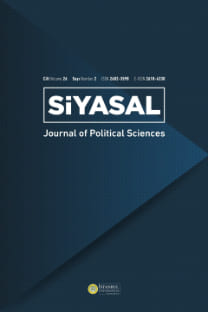KRİZ YÖNETİMİ VE AFETLERDE SOSYAL MEDYA KULLANIMI
İnsanlık tarihi kadar eski olan ve karşı karşıya kalındığında bireyler ve örgütleri çeşitli tehlikelere maruz bırakan afetler ve krizleri yönetmede yeni ve etkili bir araç olan sosyal medya, zaman ve mekan sınırlaması olmadan çeşitli araçlar üzerinden kişi veya grupların birbirleriyle iletişimini ve bilgi paylaşımını sağlayan sanal bir platformdur. İnternet bağlantısına sahip olan çeşitli araçlar üzerinden kolay erişim sağlanabilen sosyal medyanın kullanım alanı günümüzde oldukça gelişmiştir ve gelişmeye devam etmektedir. Bu çalışmada kriz ve afet olgularına değinilerek örgütlerin bu durumlarla karşı karşıya kaldığında, bu durumları yönetebilmeleri için sosyal medyanın afet planlama ve eğitim, ortak problem çözme, karar alma, bilgi yayma ve toplama gibi amaçlarını nasıl gerçekleştirdiği incelenmektedir.
Anahtar Kelimeler:
Sosyal Medya, Kriz Yönetimi, Afet Yönetimi
Social media is a virtual platform that individuals and groups can communicate and share knowledge on a variety of tools without time and place restraining. This new and growing platform has amount of usage and evolving everyday due to the fact that easy accessing via almost every device which has an internet connection. It is a new and effective way of managing crises and disasters which is as old as human history and exposes variety of dangers when individuals and organizations face with them. In this study, crises and disasters will be defined and the use of social media for disaster planning and training, common problem solving, decision making, information dissemination and gathering will be discussed.
Keywords:
Social Media, Crisis Management, Disaster Management,
___
Kitaplar ve Makaleler ● ● ADKINS, G. L., Organizational Networks in Disaster Response: An Examination of the US Government Network’s Efforts in Hurricane Katrina, The Handbook of Crisis Communication, United Kingdom, Blackwell Publishing, 2012. ● ● AUGUSTINE, Norman R., “Managing the Crisis You Tried To Prevent”, Harvard Business Review, Vol. 78, No. 6, (November 1995), ss. 147-158. ● ● CHAN, Jason Christopher, “The Role of Social Media in Crisis Preparedness, Response and Recovery”, Vanguard, ss. 1-16. ● ● COOMBS, W. Timothy, Code Red in the Boardroom: Crisis Management as Organizational DNA, Praeger Publishers, 2006. ● ● CROWE, Adam, “The Social Media Manifesto: A Comprehensive Review of the Impact of Social Media on Emergency Management”, Journal of Business Continuity & Emergency Planning, Vol. 5, No. 1, 2011, ss. 409-420. ● ● DUFTY, Neil, “Using Social Media to Build Community Disaster Resilience”, The Australian Journal of Emergency Management, Vol. 27, No. 1, 2012, ss. 40-45. ● ● KAPLAN, A., Haenlein, M., “Users of the World, Unite! The Challenges and Opportunities of Social Media”, Business Horizons, Vol. 53, No. 1, 2010, ss. 59–68. ● ● KILDOW, Betty A., A Supply Chain Management Guide to Business Continuity, USA: Amacom, 2011. ● ● MITROFF, Ian I., Shrivastava, Paul, Udwadia, Firdaus E., “Efective Crisis Management”, The Academy of Mangement Executive, 1987, Vol. 1, No.3, ss. 283-292.ORSBURN, Eva Mayer, The Social Media Business Equation: Using Online Connections to Grow Your Bottom Line, USA: Course Technology PTR, 2012. ● ● PALEN, Leysia, Liu, Sophia B., “Citizen Communication in Crisis: Anticipating a Future of ICT-Supported Public Participation”, In Proceedings of the Conference on Human Factors in Computing System, San Jose, 2007, ss. 727-736. ● ● PEARSON, C., Mitroff, I., “From Crisis Prone to Crisis Prepared: A Framework for Crisis Management”, Academy of Management Executive, 1993, ss. 48–59. ● ● POSTMAN, Joel, SocialCorp: Social Media Goes Corporate, USA, New Riders, 200 ● ● SAFKO, Lon, The Social Media Bible: Tactics, Tools and Strategies for Business Success, 2nd Ed., Canada: Wiley, 2010. ● ● TAYLOR, M., Wells, G., Howell, G., Raphael, B., “A Facebook Study from ‘Cyclone Yasi Update’: The Role of Social Media as Psychological First aid as a Support to Community Resilience Building”, Australian Journal of Emergency Management, 2012, Vol. 27, No. 1, ss. 20-26. ● ● TUNÇ, Mehtap, “Nasuh Mahruki Röportajı”, Akademi Beykoz Dergisi, Yıl:2 Sayı: 08, ss. 1-131. ● ● VELEV, Dimiter, Zlateva, Plamena, “Use of Social Media in Natural Disaster Management”, International Proceedings of Economics Development and Research, Vol. 39, 2012, Singapore: IACSIT Press, ss. 41-45. ● ● YAZICI, Selim, İş Sürekliliği Yönetimi: Stratejik Bir Değerlendirme, İstanbul: Türkmen Kitabevi, 2013.
İnternet Kaynakları ● ● American Red Cross, “Social Media in Disasters and Emergencies”, (August 5, 2010, (Çevrimiçi) http://i.dell.com/sites/content/shared-content/campaigns/en/Documents/Red-Cross-Survey-Social-Media-in-Disasters-Aug-2010.pdf ● ● Davis, Lanny, “Tell it all, tell it early, tell it yourself”, Huffington Post, September 29, 2010 (Çevrimiçi) http://www.huffingtonpost.com/lanny-davis/tell-it-all-tell-it-early_b_744007.html ● ● Geller, Martine, “P&G dismisses Dry Max Pampers rash rumors”, Reuters, (May 06, 2010), (Çevrimiçi) http://www.reuters.com/article/2010/05/07/us-procter-pampersidUSTRE6457AH20100507 ● ● Hanlon, Mike, “Incident Commander Simulation Software for Emergency Personnel”, (September 6, 2006). (Çevrimiçi) http://www.gizmag.com/go/6121/ ● ● Lindsay, Hugh, vd., Crisis Management for Directors, Canada: Canadian Institute of Chartered Accountants, (Çevrimiçi) http://www.ica.bc.ca/pdf/cicapubs_crisisdirectors. pdf
Mayfield, Anthony, “What is Social Media?”, (August 08, 2010), iCrossing, (Çevrimiçi), http://www.icrossing.com/sites/default/files/what-is-social-media-uk.pdf ● ● Washington, Crystal, “The Role of Social Media During Natural Disasters”, (Çevrimiçi) http://crystalwashington.com/the-role-of-social-media-during-natural-disasters/ ● ● “Crowdsourcing, The Gulf Oil Spill and the Arrogance of BP”, (June 25, 2010), (Çevrimiçi) http://blog.crowdspring.com/2010/06/crowdsourcing-bp-oil-spill-innocentive/ ● ● http://tr.wikipedia.org/wiki/Sosyal_medya (Çevrimiçi)
- ISSN: 1303-1260
- Yayın Aralığı: Yılda 2 Sayı
- Yayıncı: İstanbul Üniversitesi
